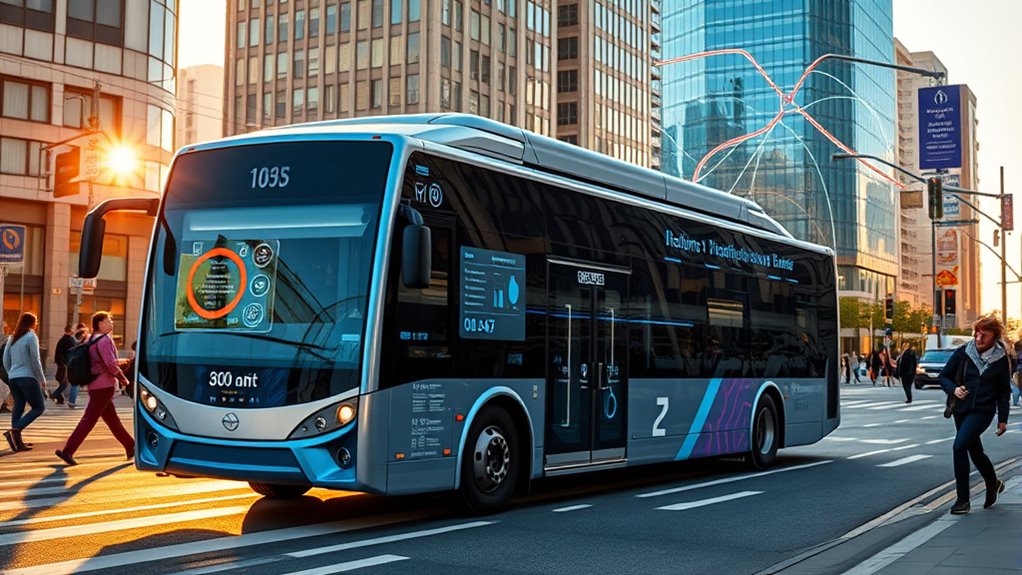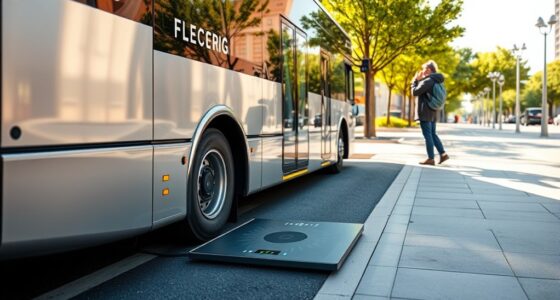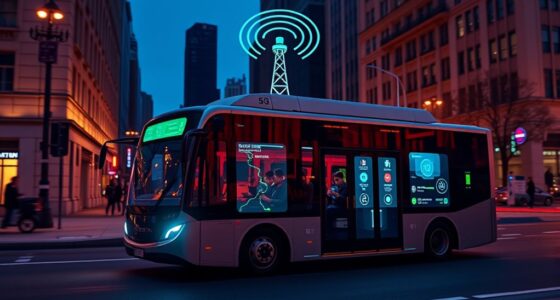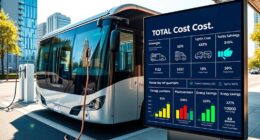AI plays a crucial role in optimizing electric bus routes by providing real-time, data-driven insights that improve efficiency and extend battery life. It considers weather, traffic, and driving patterns to plan smarter routes, reducing energy waste and operational costs. By adapting on the fly to changing conditions, AI helps you make better decisions and enhances overall system responsiveness. Continue exploring how AI can revolutionize electric bus operations and sustainability.
Key Takeaways
- AI enhances route planning by adapting to real-time traffic and weather data, reducing energy waste and travel time.
- It estimates and optimizes energy consumption based on driving patterns and environmental factors to extend battery life.
- AI enables dynamic route adjustments, improving responsiveness to traffic, weather, and operational changes.
- It forecasts future energy needs and schedules charging to minimize costs and maximize battery efficiency.
- AI-driven data analysis improves overall system responsiveness, leading to greener, cost-effective electric bus operations.
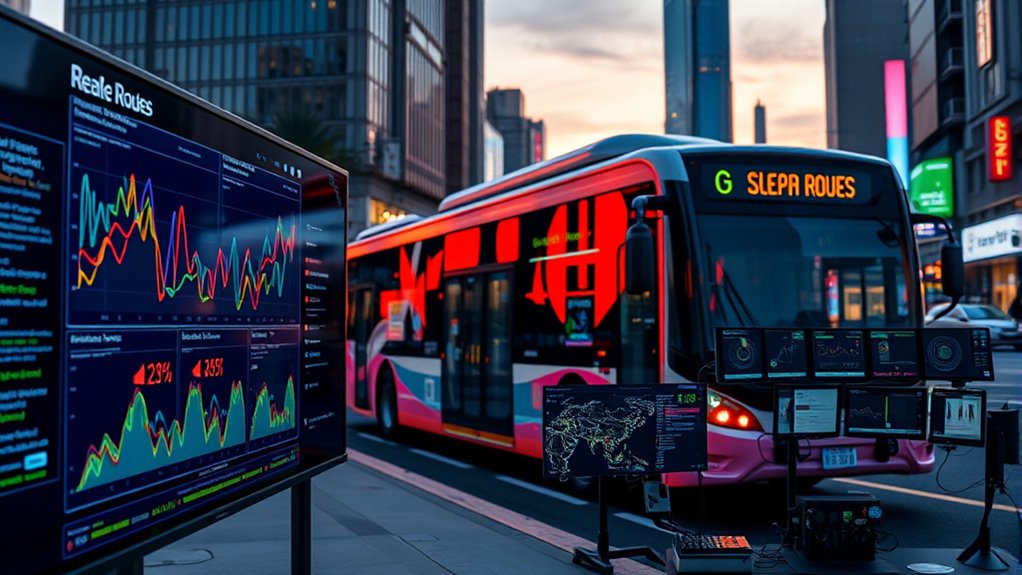
Artificial intelligence is transforming electric bus route optimization by enabling more accurate and adaptive planning. As someone involved in managing or designing bus routes, you’ll find AI’s ability to estimate energy consumption particularly valuable. This capability considers multiple factors like weather and traffic conditions, which directly influence how much energy your buses will use on each route.
AI enhances electric bus route planning by accurately estimating energy use amid weather and traffic variations.
This means you can plan routes that aren’t only efficient but also tailored to real-world conditions, reducing unnecessary energy waste. By leveraging AI, you can predict how different driving styles impact energy use, creating more precise speed profiles that help optimize battery life and extend vehicle range.
AI models thrive on real-world data, learning from actual driving patterns to improve their accuracy over time. As you gather more data from your fleet, the AI system continually refines its predictions, making route adjustments on the fly to account for changing traffic flow, weather shifts, or road conditions. Incorporating real-time data analysis enhances the system’s responsiveness and accuracy in dynamic environments.
This adaptive modeling allows your operations to stay flexible, ensuring your buses conserve energy even when unexpected disruptions occur. The predictive capabilities of AI go beyond just current conditions—they analyze historical data to forecast future energy needs, helping you prepare for peak usage times or plan charging schedules more effectively. Additionally, leveraging advanced data processing techniques can further improve the system’s ability to handle complex variables, ensuring reliable performance.
Additionally, AI security measures help protect sensitive operational data from cyber threats, ensuring the integrity of your route optimization system. The development of robust cybersecurity protocols is crucial as reliance on digital systems increases in transit operations.
Operational efficiency is a key benefit of AI-driven route optimization. By analyzing demand patterns and traffic flows, AI systems help you select routes that minimize travel time and energy consumption.
This not only reduces costs associated with fuel or electricity but also lessens wear and tear on your buses. With AI, resource allocation becomes smarter, enabling you to assign vehicles where they’re needed most and avoid unnecessary detours.
Such optimization also contributes to a greener footprint, as reducing energy consumption directly impacts your fleet’s environmental impact.
Implementing AI isn’t without challenges, though. High-quality data is essential; inaccurate or incomplete information can impair the system’s effectiveness. Managing the complexity of variables like weather and traffic requires advanced AI algorithms capable of quick decision-making.
These models need to learn continuously from new data, demanding ongoing updates and maintenance. Additionally, integrating AI with existing infrastructure, especially charging stations, is vital for seamless operation.
As your fleet grows, scalability becomes a concern—your AI solutions must evolve to handle increased demand and more routes without losing performance.
Frequently Asked Questions
How Does AI Handle Unexpected Route Disruptions in Electric Bus Networks?
When unexpected route disruptions happen, AI quickly analyzes real-time data like traffic, weather, and vehicle status. It automatically generates alternative routes, reschedules driver shifts, and updates passengers via apps.
AI also checks charging station availability and reroutes buses to avoid delays or stranded vehicles. By continuously learning from disruptions, AI improves future responses, helping you maintain efficiency and passenger satisfaction despite unforeseen challenges.
What Data Sources Are Most Important for AI Route Optimization?
Imagine you’re using a smartphone app in a bustling city to find the fastest route. The most important data sources for AI route optimization include real-time traffic patterns and road conditions to avoid delays, passenger demand and public transit data for efficient scheduling, and vehicle performance metrics to guarantee energy efficiency. Combining these, AI can dynamically adapt routes, saving time and energy while improving passenger experience.
How Does AI Improve Passenger Wait Times on Electric Bus Routes?
You see, AI improves passenger wait times by predicting demand using historical data and adjusting schedules accordingly. It integrates real-time traffic updates to fine-tune routes, reducing delays.
During peak hours, AI increases bus frequency, ensuring you don’t wait long. By dynamically managing schedules and dispatching, it keeps the buses running smoothly and on time, making your commute quicker and more reliable.
Can AI Predict Future Demand for Electric Bus Services?
Did you know AI can predict demand with up to 90% accuracy? When you ask if AI can forecast future electric bus service needs, the answer is yes. It analyzes historical data, seasonal trends, and real-time info to project passenger numbers.
This helps you plan routes, allocate buses efficiently, and expand services where demand will grow. So, AI guarantees your electric bus network is ready for the future.
What Are Privacy Concerns Related to AI Route Data Collection?
You might worry about privacy concerns with AI collecting route data. It can gather personal info like location and travel habits without your clear consent, raising privacy issues.
Data storage risks theft or misuse, especially if sensitive data like biometric info is involved.
Covert collection and lack of transparency make it harder to trust how your data is used.
To protect your privacy, clear policies, consent, and encryption are essential.
Conclusion
By harnessing AI, you can optimize routes, reduce costs, and improve efficiency. By embracing technology, you empower your fleet to be smarter, faster, and more sustainable. By leveraging data, you make informed decisions that benefit your operations and the environment. And by integrating AI, you stay ahead of the curve, lead innovation, and create a better future for transportation. The future of electric buses is here, and AI is the key to unleashing its full potential.
